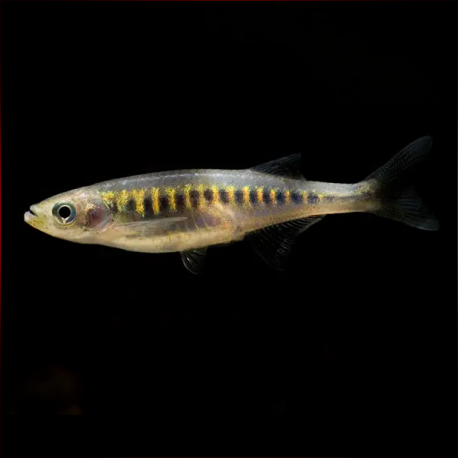More info
Datasheet
| Minimum Tank Size | 80 litres / 21.13 US gallons |
| Maximum Size | 8.0cm / 3.15inches |
| Temperature | 20°C / 68.00°F - 24°C / 75.20°F |
| Hardness | 3.03dgH / 54ppm - 15.02dgH / 268ppm |
| pH | 6.0-8.0 |
General Description
Originally described as a member of Barilius, Inlecypris Auropurpurea, is a peaceful species that may exhibit skittish behavior but can be alleviated by the presence of floating plants and companionship with other pelagic species. Being a schooling fish, it is recommended to keep a group of at least 8-10 specimens in the aquarium.
Aquarium Setup
Inlecypris Auropurpurea thrives in densely-planted tanks with the addition of floating plants to reduce direct light. Water movement should not be strong, and a secure lid is necessary due to their jumping capability. Water conditions should maintain a hardness of 54-268ppm, a pH range of 6.0-8.0, and a temperature between 20-24 degrees Celsius (see table).
Behaviour
This species is known to be peaceful but may struggle in the presence of larger or more energetic tankmates. It can display skittish behavior, which can be mitigated by suitable tank conditions and the company of other similar pelagic species. Inlecypris Auropurpurea is a schooling fish, thus thriving best in groups of 8-10 individuals.
Feeding and Diet
In its natural habitat, Inlecypris Auropurpurea primarily preys on insects and aquatic invertebrates, showcasing a versatile diet. In captivity, they readily accept various foods such as good-quality dried products supplemented with live or frozen foods like bloodworms, Daphnia, and Artemia.
Reproduction & Dimorphism
Reproduction in Inlecypris Auropurpurea involves the scattering of eggs among aquatic vegetation without parental care. For controlled breeding, setting up separate containers with suitable conditions is recommended. Sexually mature females are identified by being more robust, less colorful, and slightly larger than males.
Habitat and Distribution
This species is endemic to Inlé Lake and its surrounding watershed in Shan state, Myanmar, where the lake's deterioration has led to its classification as "Endangered" on the IUCN Red List. Lake Inlé provides a clear, shallow, and fertile habitat that fosters endemic species and a unique ecosystem threatened by environmental degradation.

